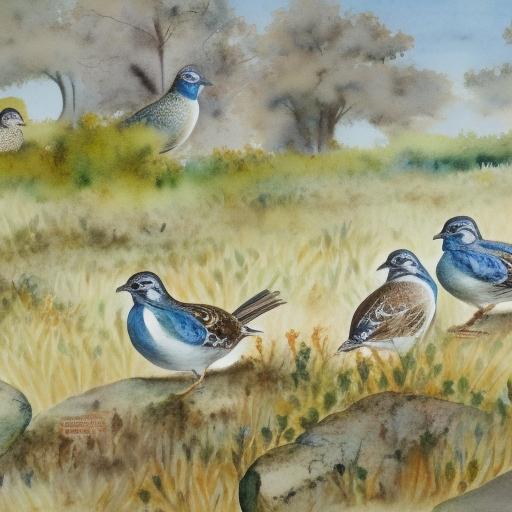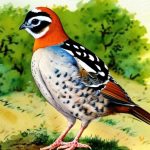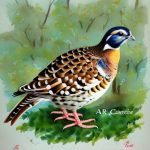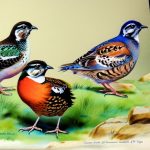Quail breeding is a fascinating and rewarding endeavor that requires a good understanding of the birds’ behavior and biology. Quails are small game birds that are known for their fast growth and high egg production. They are also relatively easy to care for, making them an ideal choice for novice breeders. Quails reach sexual maturity at around 6-8 weeks of age, and they can lay eggs as early as 8 weeks old. Understanding the breeding cycle of quails is essential for successful breeding. Quails are known to be prolific breeders, with some species laying up to 300 eggs per year. They are also known for their ability to hatch their own eggs, making them relatively low-maintenance compared to other poultry species.
Quails are monogamous birds, meaning they form long-term pair bonds with their mates. This behavior is important to consider when managing breeding pairs, as it can affect the success of breeding. Understanding the social dynamics of quails is crucial for creating a harmonious breeding environment. Additionally, quails are ground-nesting birds, so providing them with suitable nesting areas is essential for successful breeding. Understanding the natural behaviors and instincts of quails is key to creating an ideal breeding environment that mimics their natural habitat. Overall, a good understanding of quail behavior, biology, and breeding cycle is essential for successful quail breeding.
Key Takeaways
- Quail breeding requires understanding of their natural mating behaviors and reproductive cycles
- Select breeding stock based on health, size, and temperament to ensure strong offspring
- Create an ideal breeding environment with proper lighting, temperature, and nesting materials
- Manage breeding pairs by monitoring their behavior and providing a balanced diet
- Incubate quail eggs in a specialized incubator with proper humidity and turning schedule
- Care for quail chicks by providing warmth, food, and clean bedding
- Troubleshoot common breeding issues such as low fertility or egg mortality with proper diagnosis and adjustments
Selecting Breeding Stock
Selecting the right breeding stock is crucial for successful quail breeding. When choosing breeding stock, it’s important to select birds that are healthy, genetically diverse, and have desirable traits such as good egg production and fast growth. Look for birds that are active, alert, and have bright eyes and clean feathers. Avoid birds that appear sick or have any physical deformities. It’s also important to select breeding stock from different bloodlines to maintain genetic diversity and prevent inbreeding. Inbreeding can lead to genetic abnormalities and reduced fertility in offspring.
When selecting breeding stock, consider the specific traits you want to improve in your quail flock. For example, if you’re breeding quails for egg production, choose birds that come from a line of good layers. If you’re breeding for meat production, select birds with good growth rates and meat quality. It’s also important to consider the temperament of the birds, as aggressive or overly timid birds may not make good breeding stock. Overall, selecting the right breeding stock is essential for producing healthy and productive quail offspring.
Creating the Ideal Breeding Environment
Creating the ideal breeding environment is essential for successful quail breeding. Quails thrive in spacious, well-ventilated enclosures with access to natural light. Provide plenty of nesting areas with suitable nesting materials such as straw or hay. Quails are ground-nesting birds, so providing them with suitable nesting areas is crucial for successful breeding. It’s also important to provide a balanced diet that meets the nutritional needs of breeding quails. A diet high in protein is essential for egg production and chick development.
Maintaining a clean and hygienic environment is also important for successful quail breeding. Regularly clean and disinfect the breeding area to prevent the spread of diseases and parasites. Provide fresh water at all times and ensure that the birds have access to grit for digestion. It’s also important to monitor the temperature and humidity levels in the breeding environment, as these factors can affect the health and productivity of the birds. Overall, creating the ideal breeding environment involves providing suitable housing, nutrition, and hygiene to ensure the health and well-being of the breeding quails.
Managing Breeding Pairs
Managing breeding pairs is an important aspect of successful quail breeding. Quails are monogamous birds that form long-term pair bonds with their mates. When managing breeding pairs, it’s important to observe their behavior and ensure that they are compatible with each other. Avoid pairing aggressive or overly timid birds together, as this can lead to stress and reduced fertility. It’s also important to provide suitable nesting areas for the pairs to lay and hatch their eggs.
Monitoring the breeding pairs for signs of aggression or distress is crucial for successful breeding. If any issues arise between the pairs, it may be necessary to separate them and pair them with different mates. It’s also important to provide a balanced diet that meets the nutritional needs of breeding quails. A diet high in protein is essential for egg production and chick development. Overall, managing breeding pairs involves observing their behavior, providing suitable nesting areas, and ensuring they have access to a balanced diet to support successful breeding.
Incubating Quail Eggs
Incubating quail eggs is a crucial step in the quail breeding process. Quails are known for their ability to hatch their own eggs, but many breeders choose to use artificial incubation to increase hatch rates and control the breeding process. When incubating quail eggs, it’s important to use a reliable incubator that maintains stable temperature and humidity levels. The ideal temperature for incubating quail eggs is around 99-100 degrees Fahrenheit, with a humidity level of around 50-60%.
It’s important to regularly turn the eggs during the incubation process to ensure proper development. Turning the eggs prevents the embryos from sticking to the shell membrane and promotes even heat distribution. Monitor the development of the embryos by candling the eggs regularly to check for signs of fertility and development. It’s also important to maintain a clean and hygienic environment in the incubator to prevent the spread of diseases and ensure the health of the developing embryos. Overall, incubating quail eggs involves maintaining stable temperature and humidity levels, regularly turning the eggs, and monitoring the development of the embryos to ensure successful hatching.
Caring for Quail Chicks

Caring for quail chicks is an important aspect of successful quail breeding. Once the chicks hatch, it’s important to provide them with a warm and safe brooding area. Use a brooder lamp or heat plate to maintain a temperature of around 95 degrees Fahrenheit for the first week, gradually decreasing by 5 degrees each week until they are fully feathered. Provide a balanced diet high in protein to support their rapid growth and development.
It’s important to monitor the chicks for signs of illness or distress and provide prompt medical attention if needed. Ensure that they have access to clean water at all times and provide suitable bedding material such as pine shavings or straw. It’s also important to provide enrichment activities such as perches and toys to promote natural behaviors and reduce stress. Overall, caring for quail chicks involves providing a warm and safe brooding area, a balanced diet, and monitoring their health and well-being as they grow.
Troubleshooting Common Breeding Issues
Despite careful planning and management, breeders may encounter common issues during the quail breeding process. One common issue is low fertility or hatch rates, which can be caused by factors such as poor nutrition, inadequate nesting areas, or genetic abnormalities. To address this issue, ensure that the breeding pairs have access to a balanced diet high in protein and provide suitable nesting areas with proper bedding materials.
Another common issue is aggression between breeding pairs, which can lead to stress and reduced fertility. If aggression occurs between pairs, it may be necessary to separate them and pair them with different mates to promote harmony and successful breeding. Additionally, monitoring the temperature and humidity levels in the breeding environment is crucial for successful hatching and chick development.
Another common issue is disease outbreaks, which can be caused by poor hygiene or exposure to infected birds or contaminated environments. To prevent disease outbreaks, maintain a clean and hygienic environment in the breeding area, regularly disinfect equipment and provide prompt medical attention if any signs of illness are observed in the birds.
In conclusion, troubleshooting common breeding issues involves addressing factors such as nutrition, nesting areas, aggression between pairs, environmental conditions, and disease prevention to ensure successful quail breeding.
By carefully monitoring these factors and making necessary adjustments, quail breeders can increase the likelihood of successful breeding outcomes and maintain the health and well-being of their quail population. Additionally, seeking guidance from experienced breeders or avian veterinarians can provide valuable insights and support in troubleshooting any issues that may arise during the breeding process. Overall, a proactive and attentive approach to addressing common breeding issues is essential for achieving successful quail breeding results.
If you’re interested in quail breeding, you may also want to explore the mating season for turkeys. Understanding the mating behaviors of different poultry species can provide valuable insights into successful breeding practices. Check out this informative article on mating season for turkeys to gain a broader understanding of poultry breeding.
FAQs
What is quail breeding?
Quail breeding refers to the process of raising and breeding quails for their eggs, meat, or for ornamental purposes.
What are the different types of quails that can be bred?
There are several species of quails that can be bred, including the Coturnix quail, Bobwhite quail, and California quail, among others.
What are the basic requirements for breeding quails?
Basic requirements for breeding quails include suitable housing, proper nutrition, access to clean water, and a conducive breeding environment.
What is the breeding season for quails?
The breeding season for quails typically occurs in the spring and summer months, although some species may breed year-round in captivity.
How long does it take for quails to hatch their eggs?
Quail eggs typically take around 17-18 days to hatch, depending on the species and the specific incubation conditions.
What are some common challenges in quail breeding?
Common challenges in quail breeding include maintaining optimal breeding conditions, preventing diseases, and ensuring proper nutrition for the quails.
What are some potential benefits of quail breeding?
Potential benefits of quail breeding include a sustainable source of eggs and meat, as well as the potential for commercial production and sale of quail products.
Meet Walter, the feathered-friend fanatic of Florida! Nestled in the sunshine state, Walter struts through life with his feathered companions, clucking his way to happiness. With a coop that’s fancier than a five-star hotel, he’s the Don Juan of the chicken world. When he’s not teaching his hens to do the cha-cha, you’ll find him in a heated debate with his prized rooster, Sir Clucks-a-Lot. Walter’s poultry passion is no yolk; he’s the sunny-side-up guy you never knew you needed in your flock of friends!







